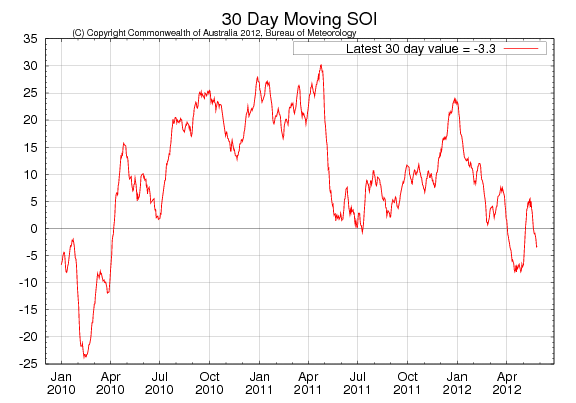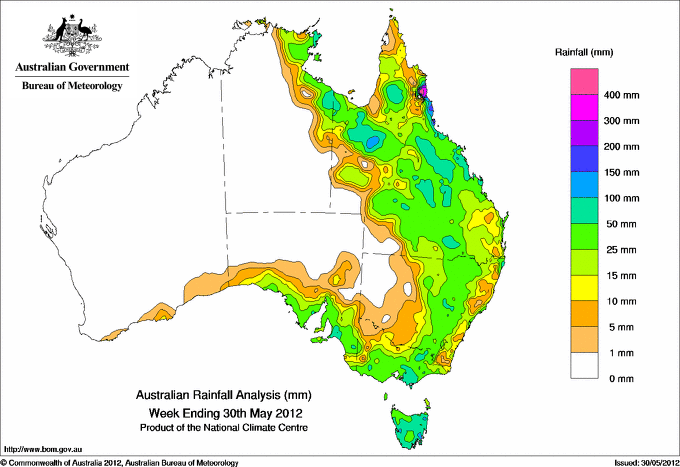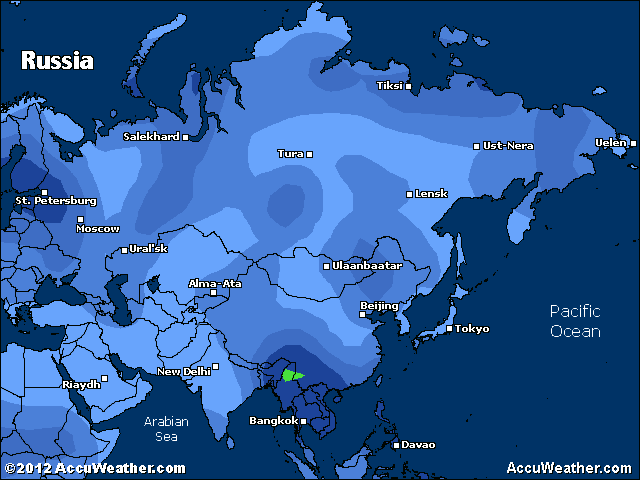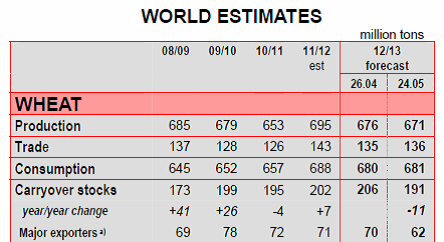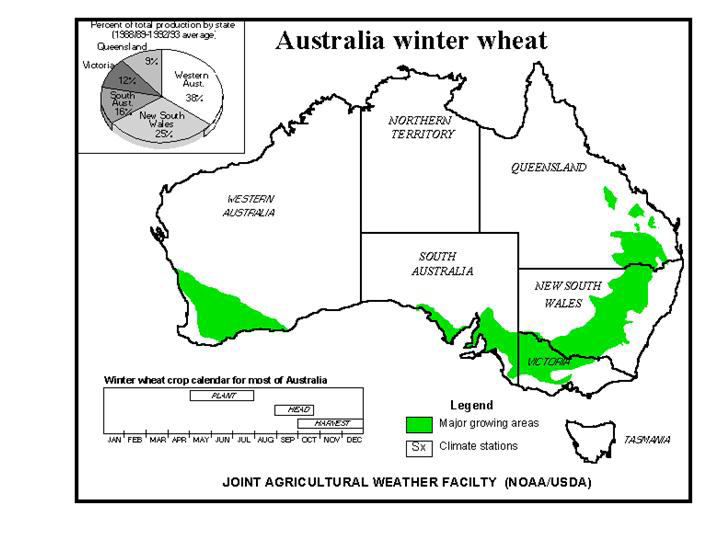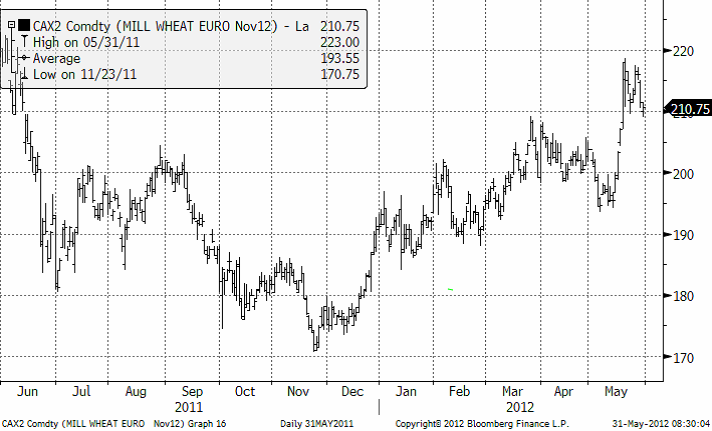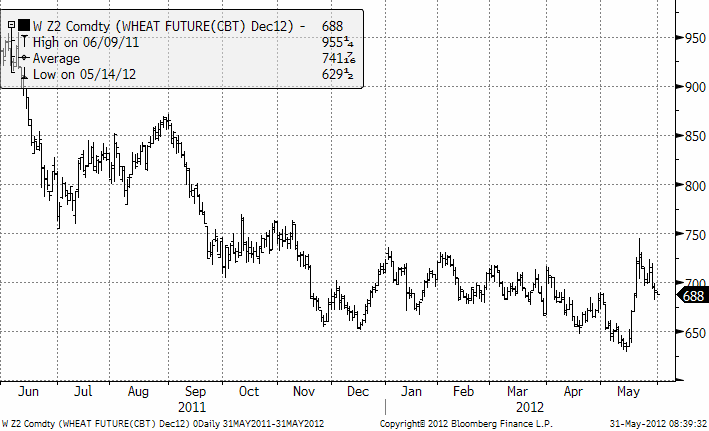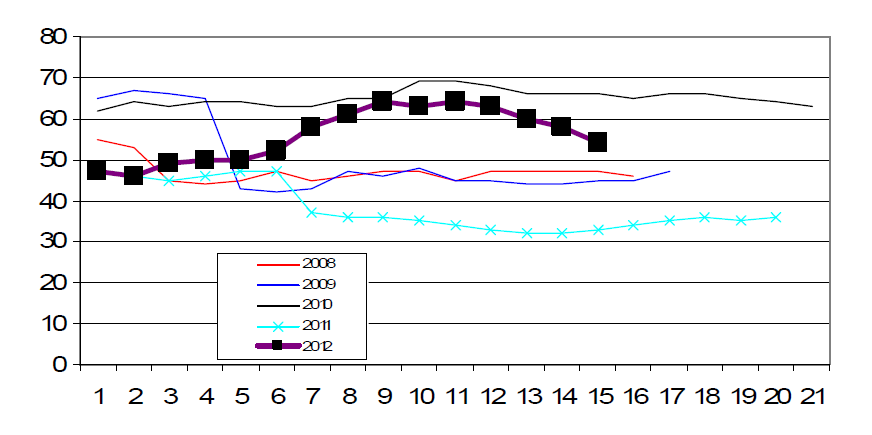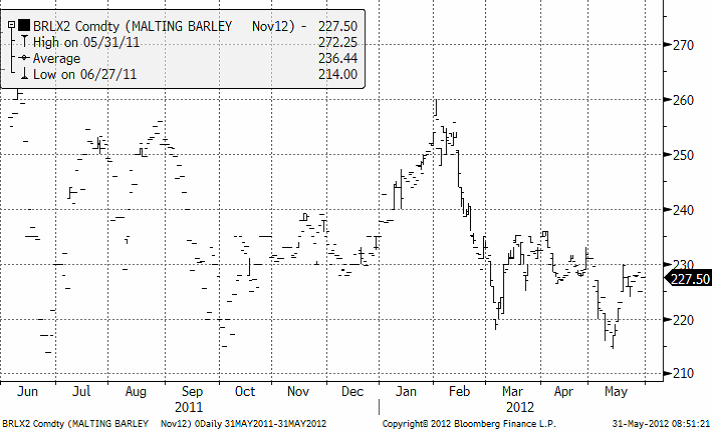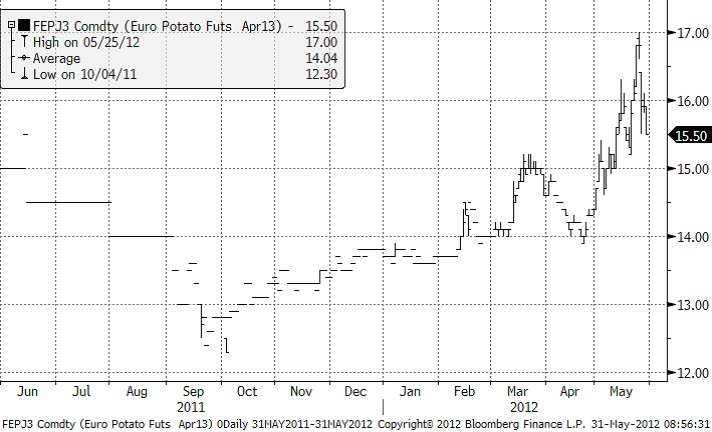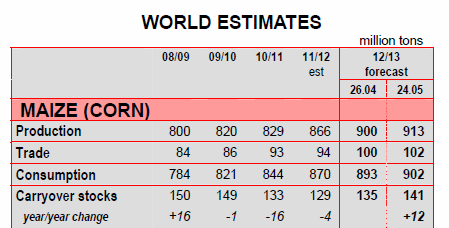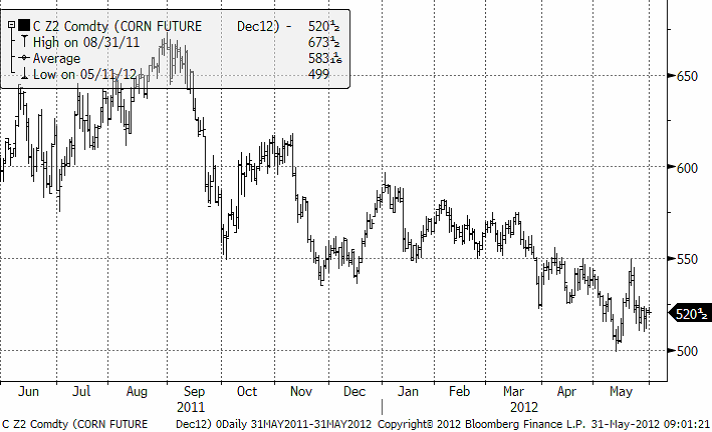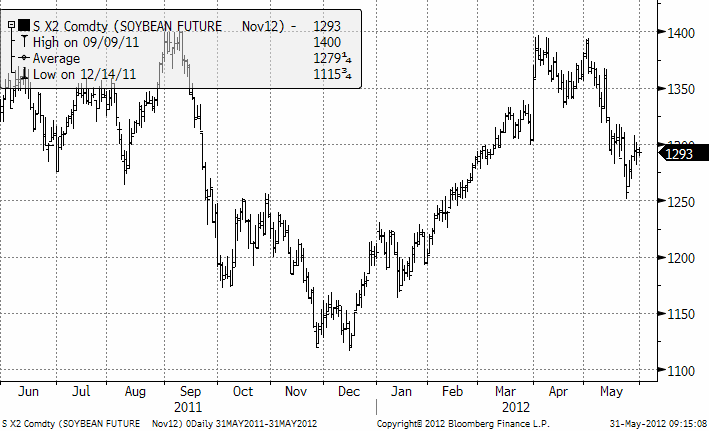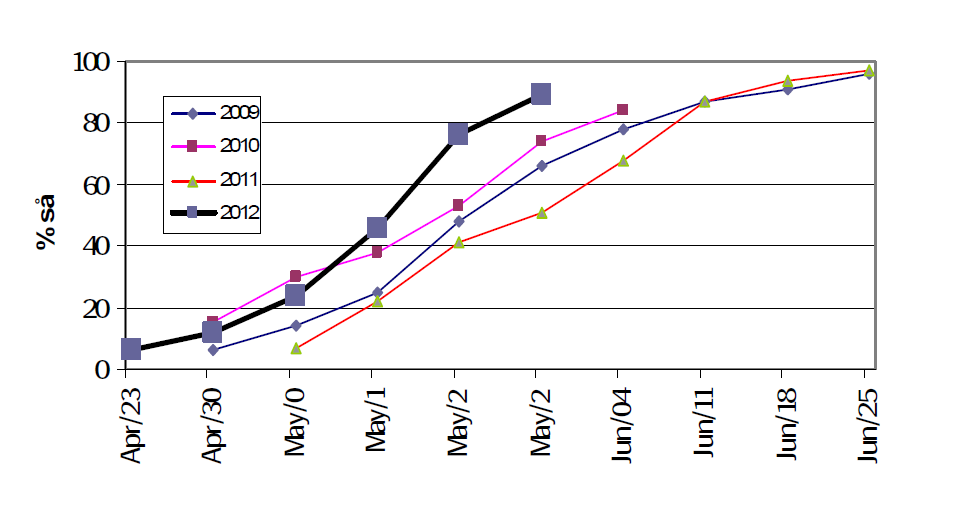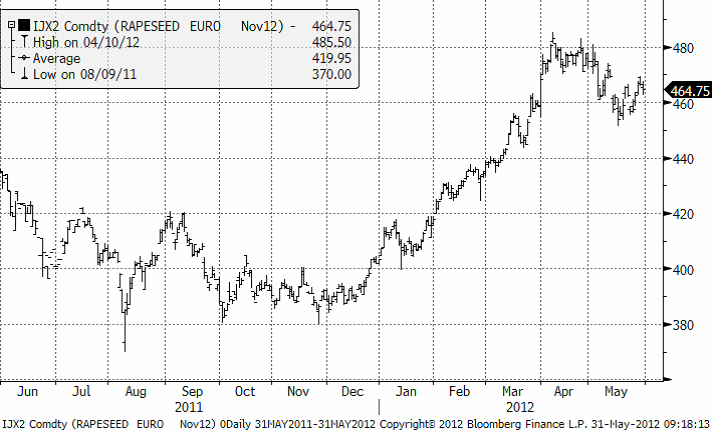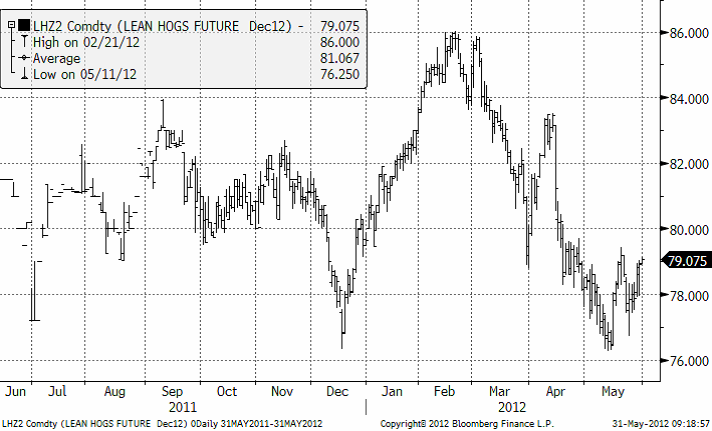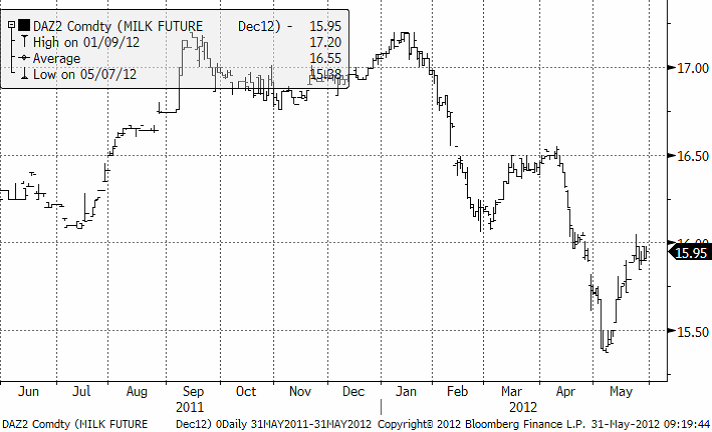Analys
SEB – Jordbruksprodukter, vecka 22 2012
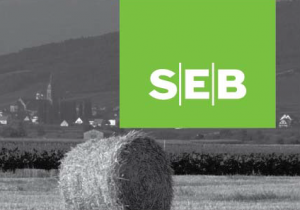 Turbulensen i Europa rasar vidare och i fredags kväll meddelade den spanska staten att de kommer att hjälpa krisdrabbade Bankia men ECB säger nej till den okonventionella metoden som spanska staten vill använda sig av. Moody’s fortsätter sin nedgradering av europeiska banker och efter att Handelsbankens och Nordeas betyg sänktes i förra veckan kom resultatet för Danmark i natt där 9 banker dras med och för Danmarks största bank, Danske Bank, sjönk betyget med två steg. Greklands premiärminister Papademos varnar för att om folket inte röstar fram en stabil regering den 17 juni så står landet inför en akut likviditetskris och från Kina kommer nyheter om att stimulanserna för att mildra avmattningen kommer att bli mindre än tidigare paket under krisen.
Turbulensen i Europa rasar vidare och i fredags kväll meddelade den spanska staten att de kommer att hjälpa krisdrabbade Bankia men ECB säger nej till den okonventionella metoden som spanska staten vill använda sig av. Moody’s fortsätter sin nedgradering av europeiska banker och efter att Handelsbankens och Nordeas betyg sänktes i förra veckan kom resultatet för Danmark i natt där 9 banker dras med och för Danmarks största bank, Danske Bank, sjönk betyget med två steg. Greklands premiärminister Papademos varnar för att om folket inte röstar fram en stabil regering den 17 juni så står landet inför en akut likviditetskris och från Kina kommer nyheter om att stimulanserna för att mildra avmattningen kommer att bli mindre än tidigare paket under krisen.
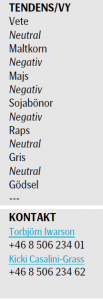 Spänningen mellan den stora oljeproducenten Iran och väst är fortfarande hög efter resultatlösa diskussioner i förra veckan om Irans kärnvapenprogram. Nya samtal är planerade till mitten a v juni och datumet för EU:s sanktioner mot Iran närmar sig nu med stormsteg.
Spänningen mellan den stora oljeproducenten Iran och väst är fortfarande hög efter resultatlösa diskussioner i förra veckan om Irans kärnvapenprogram. Nya samtal är planerade till mitten a v juni och datumet för EU:s sanktioner mot Iran närmar sig nu med stormsteg.
Marknaden för jordbruksprodukter styrs nu i mångt och mycket av väderleksrapporter och framförallt fokus på nederbörd. Efterlängtade regn i Ryssland, Svartahavsregionen, Australien och USA har dämpat oron något och därmed gjort att priserna, framförallt på vete, har fallit.
Odlingsväder
Southern Oscillation Index, ett mått på intensiteten i graden av La Niña eller El Niño, har fortsatt falla och ligger nu på –3.3. Ett värde mellan +8 och -8 indikerar neutrala ENSO-förhållanden.
Australiens spannmålsproducerande områden i öster har fått välbehövligt regn under helgen och därmed höjt förhoppningarna om en högre avkastning för 2012/13 års vete produktion.
Delar av Ryssland, Ukraina och norra Kazakstan, kommer att få svalare temperaturer och regn kommande dagar vilket gynnar grödorna.
Sverige
Enligt Jordbruksverket uppgår den totala spannmålsarealen preliminärt till 1 007 100 hektar år 2012, vilket är en ökning med 14 300 hektar (+1%) jämfört med 2011. Siffrorna för årets odlingssäsong visar att vetearealen minskar preliminärt med 45 800 (-11%) till 371 000 hektar, medan kornarealen ökar preliminärt med 47 300 hektar (+14%) till 375 000 hektar jämfört med 2011. Havrearealen ökar preliminärt med 18 700 hektar (+10%) till jämfört med år 2011.
Arealen för raps och rybs är tillbaka på 2010 års nivå, och beräknas preliminärt till 109 800 hektar år 2012, vilket är en ökning med 14 900 hektar (+16%) jämfört med 2011.
Vete
IGC (International Grains Council) skriver i sin senaste rapport att utsikterna för vete kommande säsong 2012/13 var fortsatt goda under maj, men ogynnsamma väderförhållanden i EU, Ryssland och Marocko sänker förväntningarna på kommande skördar och bidrar till att den globala produktionen justeras ned med 5 mt tilll 671 mt, en kraftig nedjustering från förra årets 676 mt.
En ökad användning av foder leder till en något högre förväntad global konsumtion på 681 mt, vilket dock fortfarande är 7 mt lägre än under 2011/12 eftersom majs förväntas ersätta vete till viss del som foder ingrediens. Detta kommer dock inte att uppväga nedgången i produktionen och globala utgående lager justeras därför ned med 15 mt till ett fyra-års lägsta på 191 mt. Exporten förväntas också bli lägre under 2012/13 jämfört med 2011/12 på grund av mindre skördar i Svartahavsregionen och minskat överskott i EU och Argentina för export.
IGC justerar ned sin prognos för Rysslands vete produktion med 3 mt till 55 mt, jämfört med 58 mt i sin senaste prognos, vilket är strax under föregående säsongs 56.2 mt. Utsikterna för grödor i Svartahavsområdet har justerats ned till följd av vårens torka.
Prognosen för EU’s vete produktion justeras ned med nästan 2 mt till 133.1 mt, en minskning från förra årets 138.2 mt och från den tidigare prognosen på 135 mt, medan Marockos produktion justeras ned från 4.0 mt till 3.3 mt , vilket är långt under det föregående årets 5.8 mt.
Kinas veteareal beräknas uppgå till 24.3 miljoner hektar under 2012/13 och landets produktion av vete estimeras till 116.0 mt jämfört med 117.9 mt under 2011/12. Kinas vete import 2012/13 estimeras till 1.8 mt, upp 20% från föregående prognos.
I Australien har flera veckor med torrt väder fått en del lantbrukare att börja oro sig, men Queensland och New South Wales – som tillsammans står för huvuddelen av landets veteproduktion – fick 25-50 mm regn i förra veckan enligt Australian Bureau of Meteorology. Trots nederbörden räknar analytikerna fortfarande med en mindre skörd i år på 24-26 mt eftersom lantbrukare förväntas ge avkall på vete till förmån för canola och boskap.
Kanadas jordbruksminister höjde förväntningarna på landets sådd och produktion av vete 2012 till 26.6 mt jämfört med 2011 års estimat på 25.26 mt. Undersökningar gjorda bland kanadensiska lantbrukare visar på att sådden av de flesta grödor förväntas öka i år till följd av torrare väder.
Vi hör från våra vänner i Indien att skörden nu är avklarad och att många lantbrukare nu migrerar till andra platser, under några månader, för att söka arbete. Indiens statliga lager fullkomligt svämmar över av vete och ris efter den tredje rekordskörden på rad. Landets spannmålslager uppgick till 71.1 mt per den 1 maj och förväntas uppgå till 80-85 miljoner ton i början av nästa månad, vilket är väl över lagringskapaciteten på 63 mt. För att minska lagren och öka lagringsutrymmet innan den nya skörden planerar regeringen att öka volymen av subventionerat vete och ris till statliga välfärdsprogram och till grossister.
Ryssland kommer sannolikt att producera omkring 56 mt vete i år, ungefär lika mycket som förra året, och landets exportpotential av vete under säsongen 2012/13 beräknas uppgå till 22-23 mt enligt Russian Grain Union.
Matifvetet med novemberleverans steg i slutet av förra veckan på rapporterna om torka i framförallt Ryssland, men också i Ukraina och USA. Men nya prognoser denna vecka som har innehållit regn har fått priset att falla tillbaka. Igår onsdag sjönk priset under stödnivån på 210 men vände sedan uppåt och stängde på 210.75.
Nedan ser vi Chicagovetet med leverans i december.
Crop condition för höstvetet i USA, som rapporterades i tisdags kväll (eftersom det var helgdag, Memorial Day, i USA i måndags), ligger nu på 54% good / excellent och det är 4% lägre än förra veckan.
Maltkorn
Kanadas jordbruksminister estimerar landets korn produktion till 9.2 mt jämfört med 7.76 mt året innan. Novemberkontraktet på maltkorn har inte påverkats värst mycket av torkoron på vetemarknaden och prisnivån har hållit sig runt 228 eur.
Potatis
Potatispriset för leverans nästa år, föll tillbaka under fredagskvällen.
Majs
IGC har reviderat upp den globala majs produktionen för 2012/13 med 13 mt till rekordhöga 913 mt, främst till följd av förbättrade utsikter i USA, Kina och Brasilien. Ingående lager justeras upp med 6 mt till 141 mt, långt över förra säsongens 129 mt. Utbudet förväntas vara stabilt (jämfört med 2011/12) och majs kan komma att ersätta en del av vete som foder ingrediens. Globala majs lager, förväntas däremot att öka till ett tre-års högsta i slutet av 2012/13 till följd av en rekordhög produktion.
USA’s produktion av majs beräknas uppgå till 355 mt, en ökning med 13% på årsbasis. Ukrainas produktion av majs beräknas till rekordhöga 24 mt, en ökning med 5.3% från 2011, och exporten till 14 mt – vilket är i linje med USDA prognos. Argentinas export av majs under 2011/12 estimeras till 12.5 mt, ned 20% från förra året. Kinas majsareal 2012/13 beräknas uppgå till 34.4 miljoner hektar, en ökning med 1 miljon från tidigare estimat, och landets produktion av majs estimeras till 189 mt, jämfört med det tidigare estimatet på 186 mt. Prognosen för Kinas import av majs ligger på 7 mt, vilket är en ökning med 1 mt från tidigare estimat och också 1 mt högre än USDA senaste prognos. Användningen av majs inom industrin estimeras till 53 mt och som foder till 129 mt.
Ukrainas jordbruksminister säger att landet vill exportera 3 mt majs till Kina under säsongen 2012/13.
Uttalandet kom dagen efter att Argentina visat nya framsteg i sina försök att få åtkomst till Kina för sin export av majs, en kampanj som tidigare har stannat av pga av oro över genetiskt modifierade grödor.
Förbättrat utsäde har höjt Ukrainas potential för att odla majs och grödan har blivit alltmer populär bland ukrainska lantbrukare, delvis som ett alternativ till vårsådden av solrosor, men också pga av marknaderna för majs såsom biobränsle och djurfoder. Arealen för majs förväntas uppgå till 4.5 miljoner hektar jämfört med 3.5 miljoner hektar året innan.
Nedan är några av prognoserna för Ukrainas majs produktion 2012: Agritel: 24 mt USDA: 24 mt ProAgro: 22 mt UkrAgroConsult: 21.25 mt
Buenos Aires Cereals Exchange sänker sin prognos för landets majsproduktion 2011/12 till 19.3 mt mot tidigare estimat på 19.8 mt medan Cordonnier justerar ned sin prognos från 19.0 mt till 18.75 mt. Brasiliens produktion av majs 2011/12 justeras upp till 65.6 mt mot tidigare 64.0 mt av Cordonnier.
Priset på decembermajs har rört sig i intervallet 510-524 under denna vecka, medan frontkontraktet för majs noterade ett 17-månaders lägsta på 559½.
Sojabönor
IGC uppskattar att den globala produktionen av sojabönor kommer att minska med 30 mt under 2011/12, och reviderar återigen ner sin prognos för Sydamerikas produktion av sojabönor. Den senaste uppskattningen ligger på 114.4 mt för säsongen 2011/12. Nedjusteringen, 23 mt lägre sedan den första uppskattningen i september och 1.5 mt lägre än förra månadens uppskattning, kommer som en följd av svårt torka och sjukdomar. Sydamerika är världens största leverantör av sojabönor och sojamjöl från mars till augusti, då USA är klar med sin skörd, och en 16% minskning i Sydamerika skulle innebära ett stort tryck på amerikanska lager vad gäller efterfrågan.
Produktionen i Argentina estimeras till 41 mt under 2011/12, vilket är 1.9 mt lägre än föregående prognos, och estimatet för Brasiliens produktion lämna s oförändrad på 65.6 mt, vilket dock är en nedgång med 13% från rekordhöga 75.3 mt under 2010/11.
EU’s import av sojabönor förväntas sjunka med 11% till ett flerårigt lägsta om 11 mt. Importen av sojamjöl beräknas vara oförändrar på 22.4 mt och ligger fortfarande relativt högt, i linje med det femåriga genomsnittet, då en minskad import av sojabönor och ett begränsat utbud av alternativa oljeväxter ger stöd till efterfrågan.
Cordonnier uppskattar Argentinas produktion av sojabönor 2011/12 till 39.5 mt jämfört med föregående estimat på 40.0 mt och Oil World uppskattar produktionen tiill 39-40 mt jämfört med tidigare 40.5 mt.
Brasilianska bönder har sålt 86% av skörden redan. Samma tid förra året var det 65%. Man har även sålt 27% av 2013 års skörd.
Fortsatta nedjusteringar av den globala sojabönsproduktionen har gett stöd åt en uppgång i priset på sojabönor under veckan.
Sådden går fort framåt i USA är nu avklarad till 89% jämfört med förra veckans 76%. I södra USA har man skördat klart höstvetet och kan så en andra skörd av sojabönor.
Raps
Oil World sänker återigen sin prognos för EU’s raps produktion 2012, denna gång med 0.1 mt, till följd av ogynnsamma väderförhållanden vid höstsådden och sedan en bitande kall vinter som har skadat grödorna. Produktionen beräknas falla till ett 6-årslägsta på 18.10 mt, jämfört med 19.12 mt under 2011, och medföra en ökad efterfrågan på import av raps och canola.
Produktionen i Frankrike beräknas sjunka till 5.15 mt från 5.37 mt under 2011 och Polens produktion förväntas uppgå till 1.60 mt jämfört med 1.87 mt.
Skörden i Tysklands beräknas öka till 4.45 mt jämfört med 3.78 mt förra året och Storbritanniens estimerade 2.72 mt ligger nära rekordet på 2.76 mt året innan.
Oil World varnar också för en lägre skörd i Ukraina, som är en stor raps leverantör till EU, och uppskattar att produktionen där kommer att falla till 0.95 mt från 1.32 mt förra året.
Priset på novemberterminen har fortsatt att stiga. Bristen på raps, marginellt lägre förväntad produktion inom EU och nedjusteringar av den globala sojabönsproduktionen ger stöd åt prisuppgången.
Gris
Priset på decemberkontraket har i stort sett rört sig i sidled. Priset steg dock igår och kontraktet handlas nu över 79 cent.
Mjölk
Mjölkpriset ligger kvar på samma nivå som förra veckan. 16 cent är dock ett starkt motstånd och det troliga är att kursen vänder nedåt igen.
[box]SEB Veckobrev Jordbruksprodukter är producerat av SEB Merchant Banking och publiceras i samarbete och med tillstånd på Råvarumarknaden.se[/box]
Disclaimer
The information in this document has been compiled by SEB Merchant Banking, a division within Skandinaviska Enskilda Banken AB (publ) (“SEB”).
Opinions contained in this report represent the bank’s present opinion only and are subject to change without notice. All information contained in this report has been compiled in good faith from sources believed to be reliable. However, no representation or warranty, expressed or implied, is made with respect to the completeness or accuracy of its contents and the information is not to be relied upon as authoritative. Anyone considering taking actions based upon the content of this document is urged to base his or her investment decisions upon such investigations as he or she deems necessary. This document is being provided as information only, and no specific actions are being solicited as a result of it; to the extent permitted by law, no liability whatsoever is accepted for any direct or consequential loss arising from use of this document or its contents.
About SEB
SEB is a public company incorporated in Stockholm, Sweden, with limited liability. It is a participant at major Nordic and other European Regulated Markets and Multilateral Trading Facilities (as well as some non-European equivalent markets) for trading in financial instruments, such as markets operated by NASDAQ OMX, NYSE Euronext, London Stock Exchange, Deutsche Börse, Swiss Exchanges, Turquoise and Chi-X. SEB is authorized and regulated by Finansinspektionen in Sweden; it is authorized and subject to limited regulation by the Financial Services Authority for the conduct of designated investment business in the UK, and is subject to the provisions of relevant regulators in all other jurisdictions where SEB conducts operations. SEB Merchant Banking. All rights reserved.
Analys
Brent crude set to dip its feet into the high $50ies/b this week

Parts of the Brent crude curve dipping into the high $50ies/b. Brent crude fell 2.3% over the week to Friday. It closed the week at $61.29/b, a slight gain on the day, but also traded to a low of $60.14/b that same day and just barely avoided trading into the $50ies/b. This morning it is risk-on in equities which seems to help industrial metals a little higher. But no such luck for oil. It is down 0.8% at $60.8/b. This week looks set for Brent crude to dip its feet in the $50ies/b. The Brent 3mth contract actually traded into the high $50ies/b on Friday.

The front-end backwardation has been on a weakening foot and is now about to fully disappear. The lowest point of the crude oil curve has also moved steadily lower and lower and its discount to the 5yr contract is now $6.8/b. A solid contango. The Brent 3mth contract did actually dip into the $50ies/b intraday on Friday when it traded to a low point of $59.93/b.
More weakness to come as lots of oil at sea comes to ports. Mid-East OPEC countries have boosted exports along with lower post summer consumption and higher production. The result is highly visibly in oil at sea which increased by 17 mb to 1,311 mb over the week to Sunday. Up 185 mb since mid-August. On its way to discharge at a port somewhere over the coming month or two.
Don’t forget that the oil market path ahead is all down to OPEC+. Remember that what is playing out in the oil market now is all by design by OPEC+. The group has decided that the unwind of the voluntary cuts is what it wants to do. In a combination of meeting demand from consumers as well as taking back market share. But we need to remember that how this plays out going forward is all at the mercy of what OPEC+ decides to do. It will halt the unwinding at some point. It will revert to cuts instead of unwind at some point.
A few months with Brent at $55/b and 40-50 US shale oil rigs kicked out may be what is needed. We think OPEC+ needs to see the exit of another 40-50 drilling rigs in the US shale oil patches to set US shale oil production on a path to of a 1 mb/d year on year decline Dec-25 to Dec-26. We are not there yet. But a 2-3 months period with Brent crude averaging $55/b would probably do it.
Oil on water increased 17 mb over the week to Sunday while oil in transit increased by 23 mb. So less oil was standing still. More was moving.

Crude oil floating storage (stationary more than 7 days). Down 11 mb over week to Sunday

The lowest point of the Brent crude oil curve versus the 5yr contract. Weakest so far this year.

Crude oil 1mth to 3mth time-spreads. Dubai held out strongly through summer, but then that center of strength fell apart in late September and has been leading weakness in crude curves lower since then.

Analys
Crude oil soon coming to a port near you

Rebounding along with most markets. But concerns over solidity of Gaza peace may also contribute. Brent crude fell 0.8% yesterday to $61.91/b and its lowest close since May this year. This morning it is bouncing up 0.9% to $62.5/b along with a softer USD amid positive sentiment with both equities and industrial metals moving higher. Concerns that the peace in Gaza may be less solid than what one might hope for also yields some support to Brent. Bets on tech stocks are rebounding, defying fears of trade war. Money moving back into markets. Gold continues upwards its strong trend and a softer dollar helps it higher today as well.

US crude & products probably rose 5.6 mb last week (API) versus a normal seasonal decline of 2.4 mb. The US API last night partial and thus indicative data for US oil inventories. Their data indicates that US crude stocks rose 7.4 mb last week, gasoline stocks rose 3.0 mb while Distillate stocks fell 4.8 mb. Altogether an increase in commercial crude and product stocks of 5.6 mb. Commercial US crude and product stocks normally decline by 2.4 mb this time of year. So seasonally adjusted the US inventories rose 8 mb last week according to the indicative numbers by the API. That is a lot. Also, the counter seasonal trend of rising stocks versus normally declining stocks this time of year looks on a solid pace of continuation. If the API is correct then total US crude and product stocks would stand 41 mb higher than one year ago and 6 mb higher than the 2015-19 average. And if we combine this with our knowledge of a sharp increase in production and exports by OPEC(+) and a large increase in oil at sea, then the current trend in US oil inventories looks set to continue. So higher stocks and lower crude oil prices until OPEC(+) switch to cuts. Actual US oil inventory data today at 18:00 CET.
US commercial crude and product stocks rising to 1293 mb in week 41 if last nights indicative numbers from API are correct.

Crude oil soon coming to a port near you. OPEC has lifted production sharply higher this autumn. At the same time demand for oil in the Middle-East has fallen as we have moved out of summer heat and crude oil burn for power for air-conditioning. The Middle-East oil producers have thus been able to lift exports higher on both accounts. Crude oil and condensates on water has shot up by 177 mb since mid-August. This oil is now on its way to ports around the world. And when they arrive, it will likely help to lift stocks onshore higher. That is probably when we will lose the last bit of front-end backwardation the the crude oil curves. That will help to drive the front-month Brent crude oil price down to the $60/b line and revisit the high $50ies/b. Then the eyes will be all back on OPEC+ when they meet in early November and then again in early December.
Crude oil and condensates at sea have moved straight up by 177 mb since mid-August as OPEC(+) has produced more, consumed less and exported more.

Analys
The Mid-East anchor dragging crude oil lower

When it starts to move lower it moves rather quickly. Gaza, China, IEA. Brent crude is down 2.1% today to $62/b after having traded as high as $66.58/b last Thursday and above $70/b in late September. The sell-off follows the truce/peace in Gaze, a flareup in US-China trade and yet another bearish oil outlook from the IEA.

A lasting peace in Gaze could drive crude oil at sea to onshore stocks. A lasting peace in Gaza would probably calm down the Houthis and thus allow more normal shipments of crude oil to sail through the Suez Canal, the Red Sea and out through the Bab-el-Mandeb Strait. Crude oil at sea has risen from 48 mb in April to now 91 mb versus a pre-Covid normal of about 50-60 mb. The rise to 91 mb is probably the result of crude sailing around Africa to be shot to pieces by the Houthis. If sailings were to normalize through the Suez Canal, then it could free up some 40 mb in transit at sea moving onshore into stocks.
The US-China trade conflict is of course bearish for demand if it continues.
Bearish IEA yet again. Getting closer to 2026. Credibility rises. We expect OPEC to cut end of 2025. The bearish monthly report from the IEA is what it is, but the closer we get to 2026, the more likely the IEA is of being ball-park right in its outlook. In its monthly report today the IEA estimates that the need for crude oil from OPEC in 2026 will be 25.4 mb/d versus production by the group in September of 29.1 mb/d. The group thus needs to do some serious cutting at the end of 2025 if it wants to keep the market balanced and avoid inventories from skyrocketing. Given that IEA is correct that is. We do however expect OPEC to implement cuts to avoid a large increase in inventories in Q1-26. The group will probably revert to cuts either at its early December meeting when they discuss production for January or in early January when they discuss production for February. The oil price will likely head yet lower until the group reverts to cuts.
Dubai: The Mid-East anchor dragging crude oil lower. Surplus emerging in Mid-East pricing. Crude oil prices held surprisingly strong all through the summer. A sign and a key source of that strength came from the strength in the front-end backwardation of the Dubai crude oil curve. It held out strong from mid-June and all until late September with an average 1-3mth time-spread premium of $1.8/b from mid-June to end of September. The 1-3mth time-spreads for Brent and WTI however were in steady deterioration from late June while their flat prices probably were held up by the strength coming from the Persian Gulf. Then in late September the strength in the Dubai curve suddenly collapsed. Since the start of October it has been weaker than both the Brent and the WTI curves. The Dubai 1-3mth time-spread now only stands at $0.25/b. The Middle East is now exporting more as it is producing more and also consuming less following elevated summer crude burn for power (Aircon) etc.
The only bear-element missing is a sudden and solid rise in OECD stocks. The only thing that is missing for the bear-case everyone have been waiting for is a solid, visible rise in OECD stocks in general and US oil stocks specifically. So watch out for US API indications tomorrow and official US oil inventories on Thursday.
No sign of any kind of fire-sale of oil from Saudi Arabia yet. To what we can see, Saudi Arabia is not at all struggling to sell its oil. It only lowered its Official Selling Prices (OSPs) to Asia marginally for November. A surplus market + Saudi determination to sell its oil to the market would normally lead to a sharp lowering of Saudi OSPs to Asia. Not yet at least and not for November.
The 5yr contract close to fixed at $68/b. Of importance with respect to how far down oil can/will go. When the oil market moves into a surplus then the spot price starts to trade in a large discount to the 5yr contract. Typically $10-15/b below the 5yr contract on average in bear-years (2009, 2015, 2016, 2020). But the 5yr contract is usually pulled lower as well thus making this approach a moving target. But the 5yr contract price has now been rock solidly been pegged to $68/b since 2022. And in the 2022 bull-year (Brent spot average $99/b), the 5yr contract only went to $72/b on average. If we assume that the same goes for the downside and that 2026 is a bear-year then the 5yr goes to $64/b while the spot is trading at a $10-15/b discount to that. That would imply an average spot price next year of $49-54/b. But that is if OPEC doesn’t revert to cuts and instead keeps production flowing. We think OPEC(+) will trim/cut production as needed into 2026 to prevent a huge build-up in global oil stocks and a crash in prices. But for now we are still heading lower. Into the $50ies/b.
-

 Nyheter4 veckor sedan
Nyheter4 veckor sedanOPEC+ missar produktionsmål, stöder oljepriserna
-

 Nyheter2 veckor sedan
Nyheter2 veckor sedanGoldman Sachs höjer prognosen för guld, tror priset når 4900 USD
-

 Nyheter4 veckor sedan
Nyheter4 veckor sedanEtt samtal om guld, olja, fjärrvärme och förnybar energi
-

 Nyheter3 veckor sedan
Nyheter3 veckor sedanBlykalla och amerikanska Oklo inleder ett samarbete
-

 Nyheter3 veckor sedan
Nyheter3 veckor sedanGuld nära 4000 USD och silver 50 USD, därför kan de fortsätta stiga
-

 Analys4 veckor sedan
Analys4 veckor sedanAre Ukraine’s attacks on Russian energy infrastructure working?
-

 Nyheter4 veckor sedan
Nyheter4 veckor sedanGuldpriset uppe på nya höjder, nu 3750 USD
-

 Nyheter3 veckor sedan
Nyheter3 veckor sedanEtt samtal om guld, olja, koppar och stål


